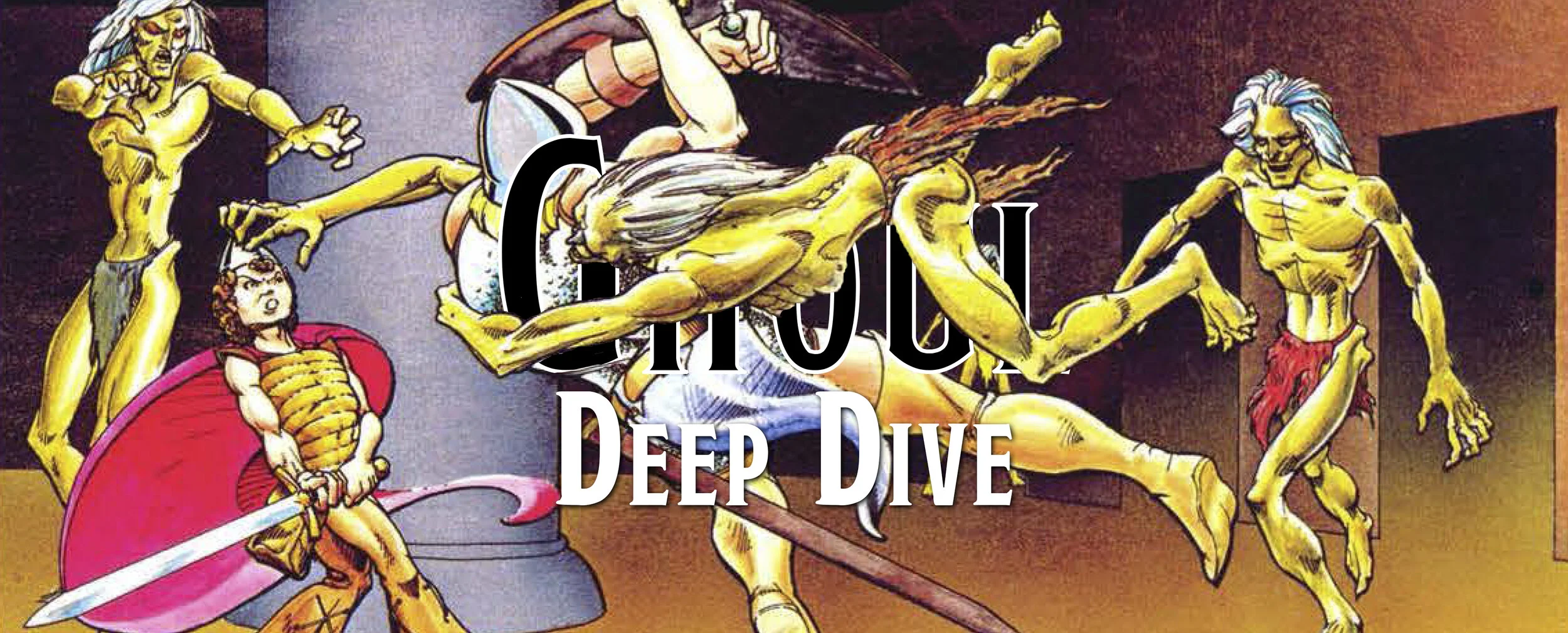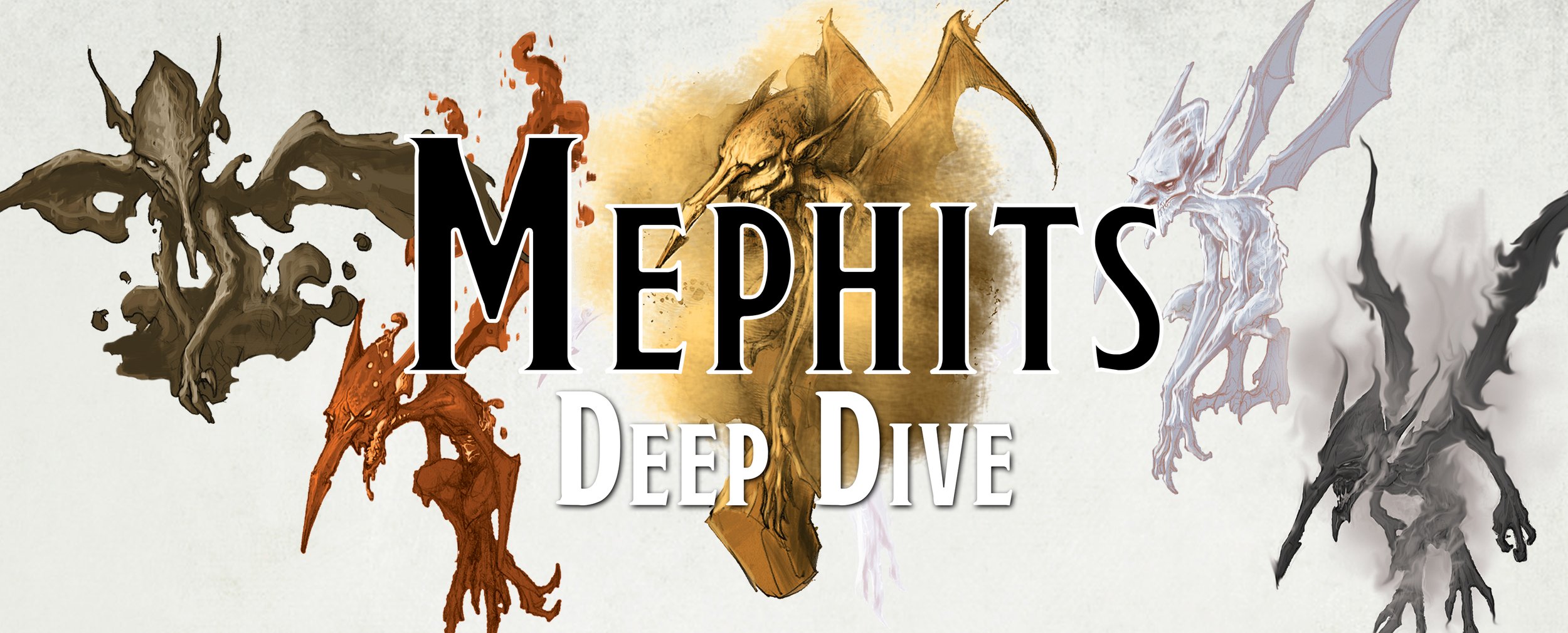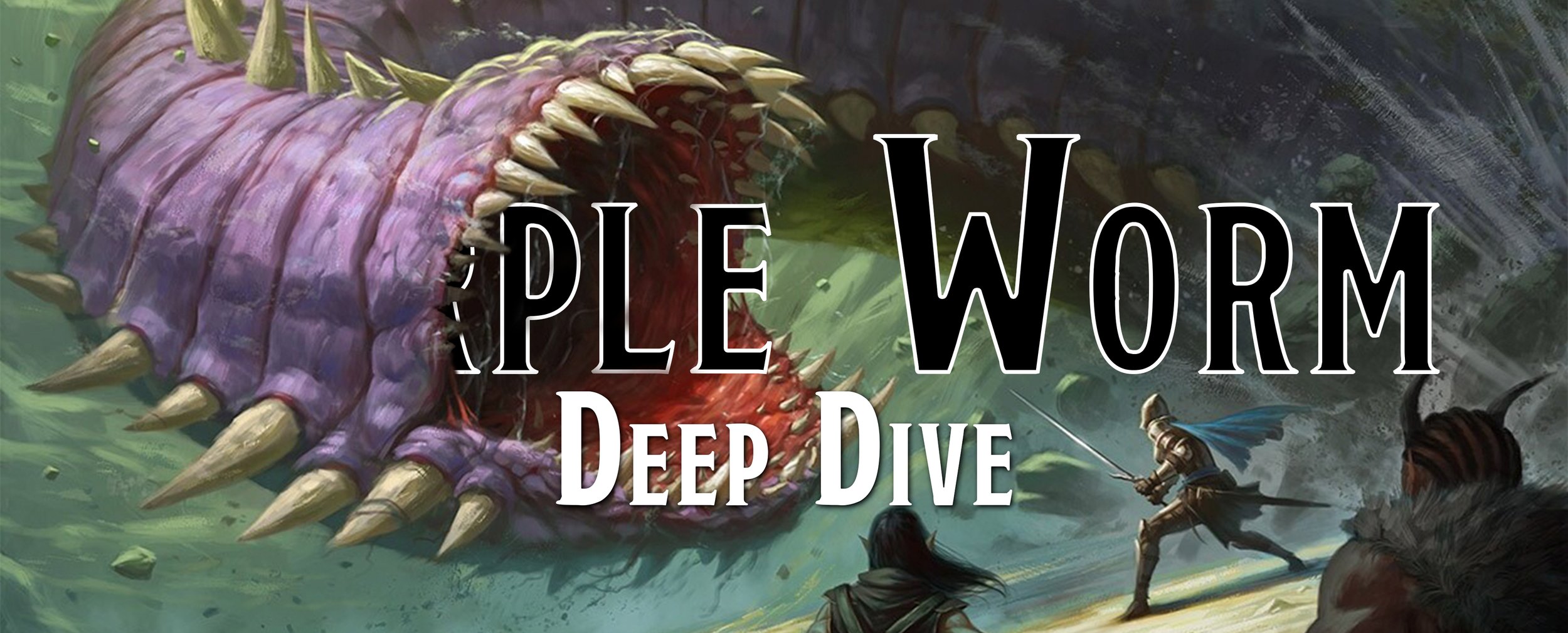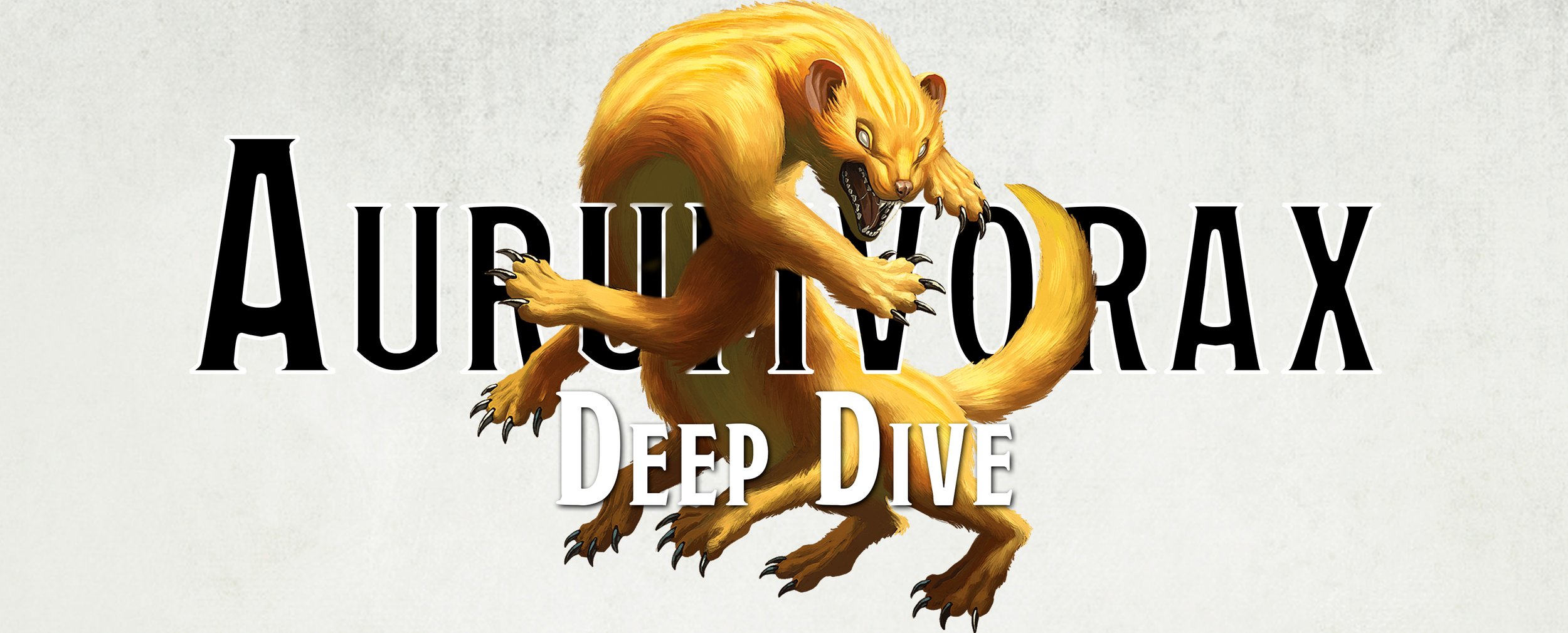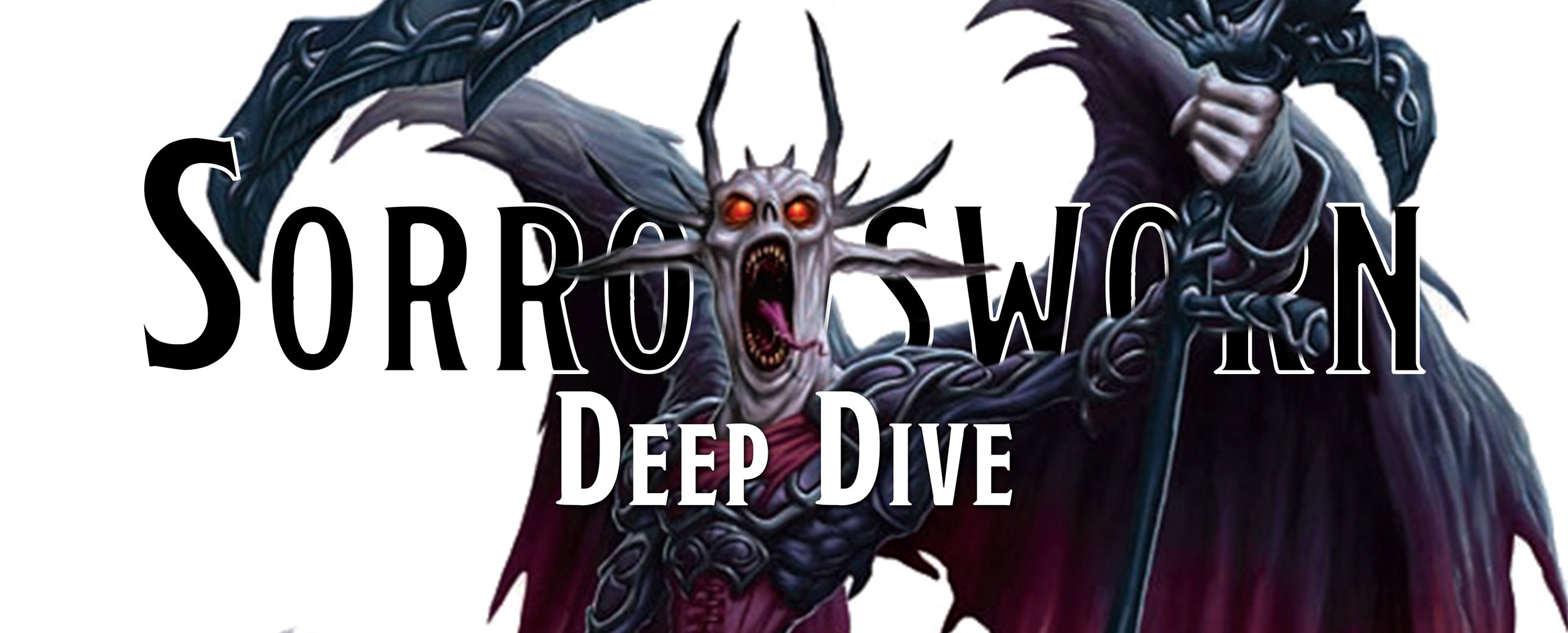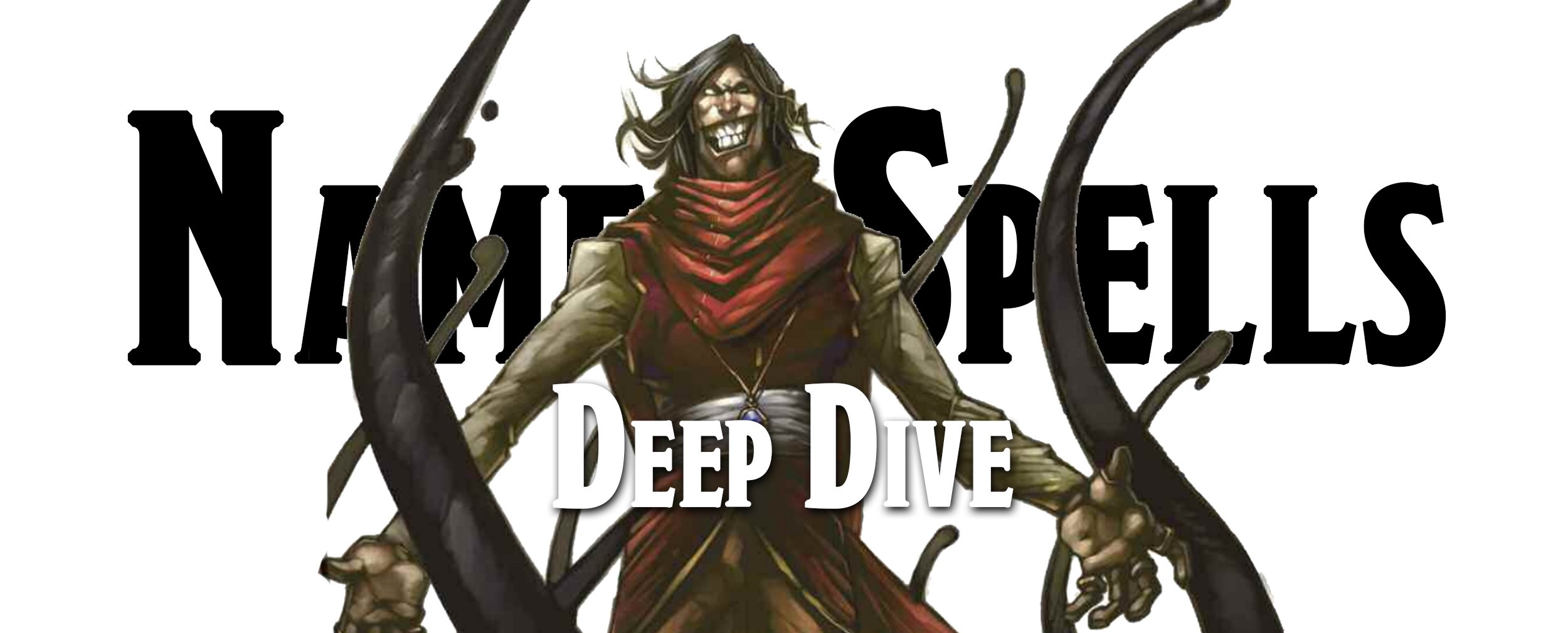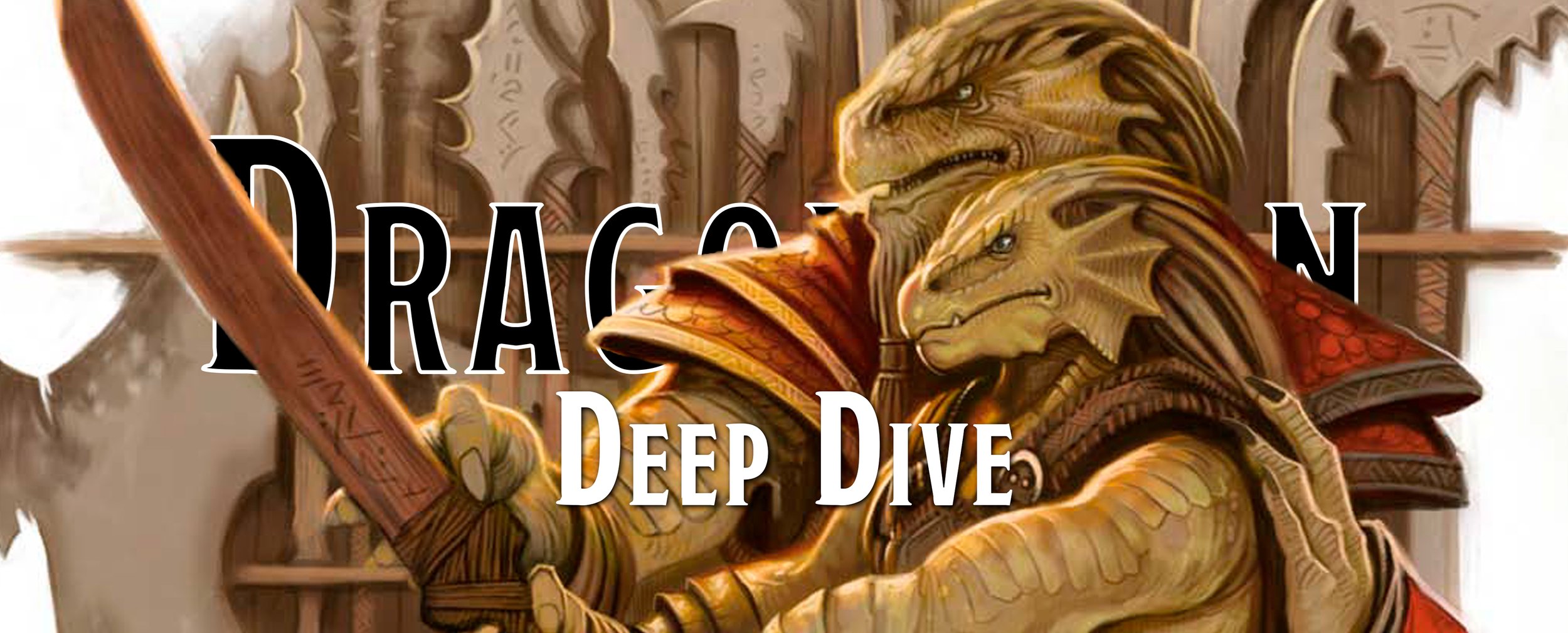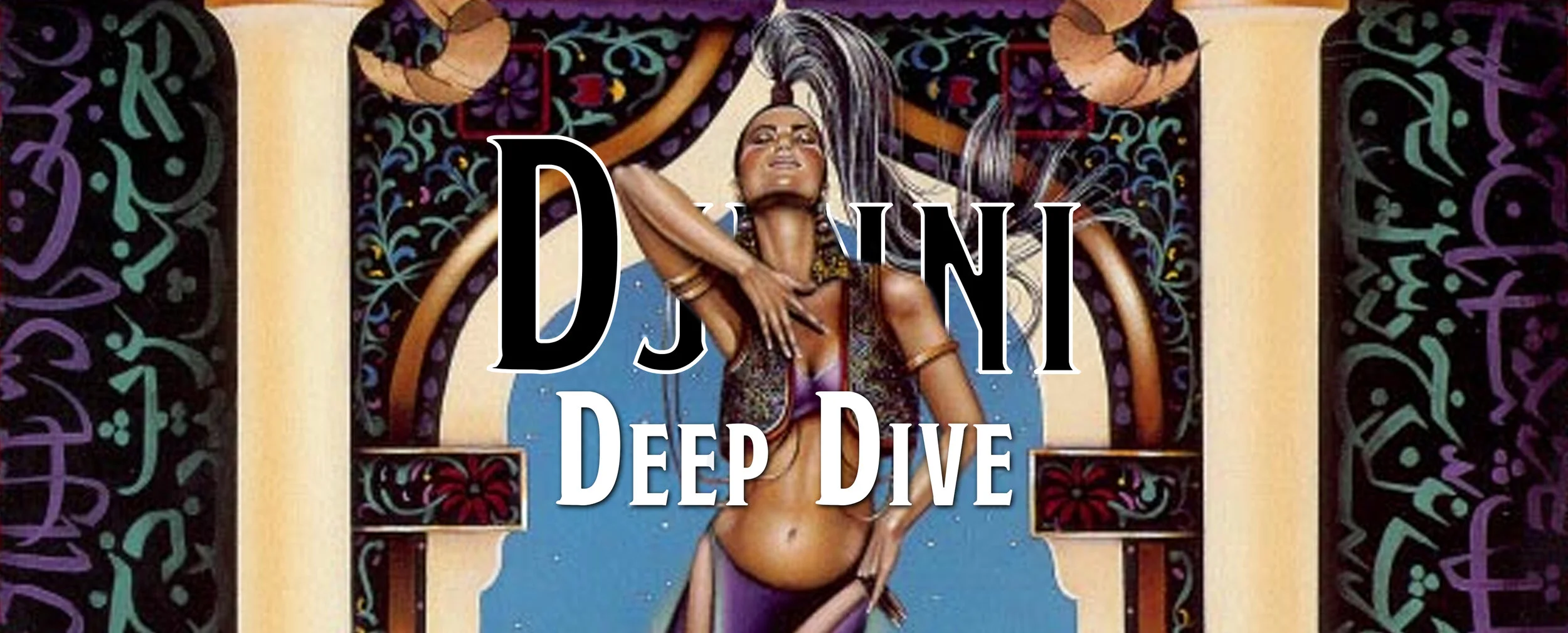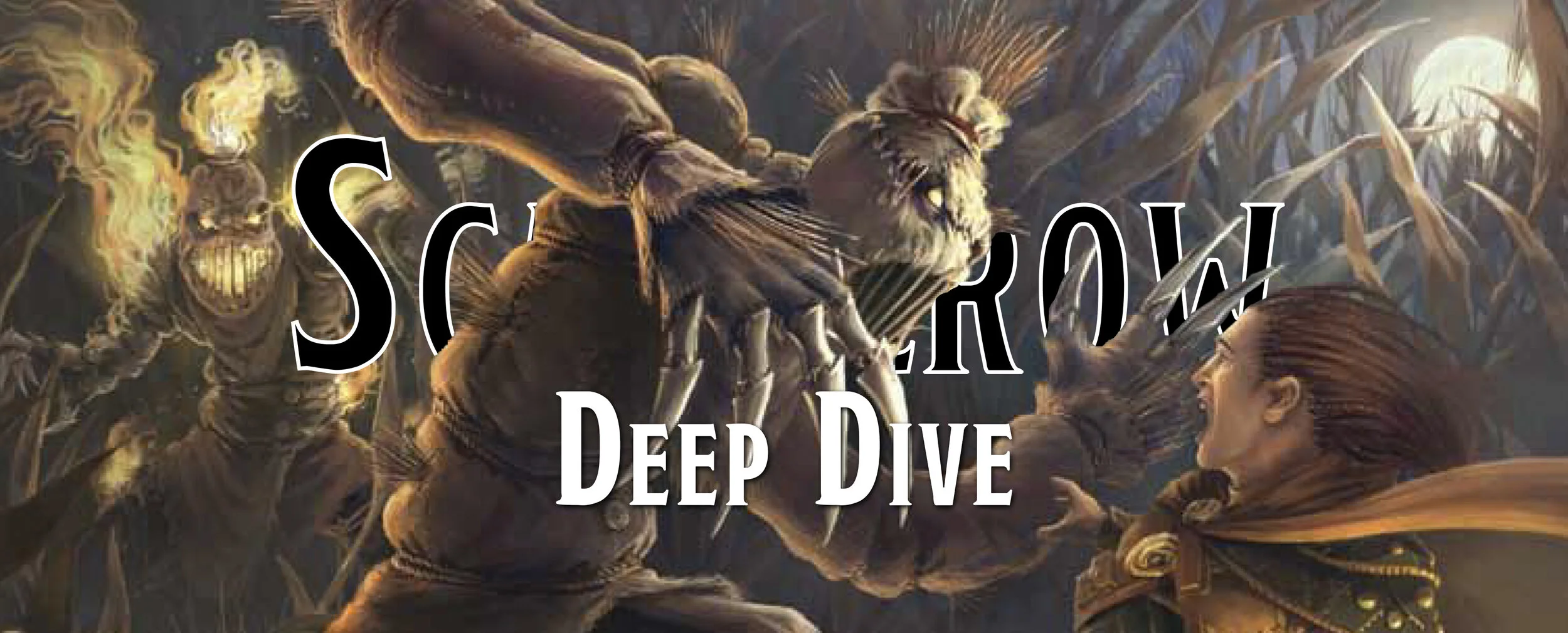Deep Dive - The Ghoul
This monster has been in Dungeons & Dragons since the beginning and it is no wonder why. The Ghoul, in our world, can trace its mythical roots back to Arabic mythology. In Arabic legend, some Ghouls might be a shapeshifting demon that can appear in the form of a hyena and lures unwary people into abandoned places to eat them. You might have guessed already, but Ghouls are really into eating flesh.
In the 8th century and before, Arabic scholars and storytellers would eventually consolidate their tales into a large collection of stories known as the One Thousand and One Nights with translations of this book eventually making its way over to Europe in the 18th century. Ghouls were featured in many of the stories where they would haunt graveyards and chow down on the decaying bodies of the dead.
Beyond their Arabic origins, the Ghoul has also appeared in many works from short stories to movies and more. The Nameless Offspring (1932) is a short story that was written by Clark Ashton Smith and presents these creatures who reproduce by mating with humans that had the misfortune of being buried alive. In H.P. Lovecraft’s Pickman’s Model (1927), the artist Pickman is fascinated by the Ghoul and creates a massive portrait of such graphic nature that he is removed from the Boston Art Club. In the Lion, the Witch, and the Wardrobe (1950), Ghouls serve as the White Witch's minions. They appear in the movie The Monster Club (1981), in the TV show Supernatural (2005), and in more pop culture media spanning from Harry Potter to Tokyo Ghoul.
In Dungeons & Dragons, the undead Ghoul is a creature that lurks in graveyards and loves to chew on humanoid flesh, they may not be the most powerful of creatures but are not to be underestimated. We should take this moment to briefly explain the difference between Ghouls and zombies. Zombies are undead automatons in Dungeons & Dragons and don’t crave brains but rather follow the orders given to them. Ghouls are much closer to the undead beings you might know from the George A. Romero movies, like Night of the Living Dead (1968). In fact, those misnamed ‘zombies’ in Romero’s films, and in much of pop culture, act more like traditional Ghouls than traditional zombies from Haitian folklore - so, looks like Dungeons & Dragons used the right classification for this undead creature which wishes to devour your face instead of just blindly follow orders.
OD&D - Ghoul
No. Appearing: 2-24
Armor Class: 6
Move: 9”
Hit Dice: 2
% in Lair: 20%
No. of Attacks: 1 claw / 2 bite
Damage/Attack: -3 claw / 1-4 bite
Treasure: Type B
White Box Set, 1974 TSR Inc.
The Ghoul makes its appearance in the system Chainmail (1971), which lumped it together with the wight. It’s important to remember that Chainmail was more of a wargaming / mass combat game since wights and Ghouls attack with the stats of a light horse, defend as a heavy horse, and cannot be harmed by normal missile fire. A light horse has incredible movement speed, but its attacks are average. Defending as a heavy horse, however, makes them the toughest unit on the battlefield. Which is a pretty fascinating mix of abilities for our humble Ghoul, not to mention the paralysis they also get.
Greyhawk Supplement, 1975 TSR Inc.
In their debut for OD&D, being revealed in the White Box Set (1974), the Ghouls are given a teensy bit more information in that they paralyze all creatures, except elves, with their very touch. We aren’t entirely sure where this paralyzing touch came from, though Gary Gygax reveals on Enworld.org (When Did Ghouls Become Undead, 2007) that the reason for this paralyzing ability is due to the negative energy of the Ghoul. In fact, Gygax had envisioned that the Ghoul was more of a progressive level for undead and that there would have been a progression of undead monsters from skeletons to zombies, and from ghouls to more powerful undead, similar to how class progression would work where a wizard would first start out as a prestidigitator eventually becoming an evoker or necromancer as they grew more powerful.
The last unique ability of the Ghoul is that if you are unfortunate enough to be killed by one, you become a Ghoul. This sounds pretty fun until you realize that your diet consists solely of flesh and rotting corpses. Not sure about you, but that’s not a meal we want to survive on.
Basic D&D - Ghoul
Armor Class: 6
Hit Dice: 2*
Move: 90’ (30’)
Attacks: 2 claws/1 bite
Damage: 1-3/1-3/1-3 + special
No. Appearing: 1-6 (2-16)
Save As: Fighter: 2
Morale: 9
Treasure Type: B
Alignment: Chaotic
XP value: 25
The Ghoul is introduced in the Holmes Box Set (1974) followed by the Moldvay/Cook Basic Box Set (1981) and in the BECMI Basic Rules Box Set (1983). While each version remains closely tied to each other, there are a few major things we want to point out. The first major issue we are going to address is that Holmes Box Set's first sentence describes the Ghoul as hideous, while the other two sets at least wait until the second sentence to start the cruel name-calling. While we agree that ghouls are not adorable, if people kept calling us hideous, we’d pry want to eat their faces too.
Holmes Box Set, 1974 TSR Inc.
Up next, Moldvay/Cook and BECMI describe the Ghoul as an undead creature, which is the first time it is specifically mentioned that they are undead. Sure, they show up on creatures that are affected by turn undead but no one has told the Ghoul, to its hideous face, that it is undead. Because of their undead nature, they are immune to sleep and charm abilities, which really makes it hard for a wizard to use their cool spells like sleep or charm monster on them. Oh well, they always have fireball to fall back on.
BECMI Box Set, 1983 TSR Inc.
Described in every version as hideous and beast-like, these Ghouls will attack any living thing… so long as it is the size of an ogre or smaller. This makes them quite vicious and they only stop attacking once they have killed everyone around them, though they have a very interesting tactic. While they still paralyze on a hit, creatures can now attempt a saving throw vs paralyzation. In addition, if a Ghoul is successful in paralyzing a creature… it doesn’t maul them to death right then and there. Instead, it simply turns to the next non-paralyzed creature and tries to paralyze them with its touch. It continues to do this until everyone is either paralyzed, dead, or it dies which makes for a very weird fight. They aren’t so mindless as to not realize what they are doing, which means they have some intelligence and tactical mind, but they also just like paralyzing creatures so they can take their time in slaughtering you and your party.
BECMI Box Set, 1983 TSR Inc.
Another fascinating part about the Ghoul can be found in their base stats, and that is their morale. In Basic D&D, every creature was assigned a Morale Score which could be between 2 and 12. During a fight, when a creature is taking damage, its allies are dying, or at an appropriate time of the DM’s choosing, the DM rolls 2d6 and then compares that result to the creature’s Morale. If they roll the target’s number or higher, the creature either flees or surrenders. Creatures with a Morale of 2 rarely or never will fight, while those with a 12 will fight to the death every time.
The Ghoul has a Morale of 9, which is quite high but not fight to the death. In fact, zombies and wights have a Morale of 12, meaning they will happily fight to the death. So the Ghoul is an undead, but it isn’t a dumb undead who has no sense of self-preservation. While these versions don’t tell you that the Ghouls are intelligent, you can start piecing together that there is more to the Ghoul than just a craving for brains.
AD&D - Ghoul
Frequency: Uncommon
No. Appearing: 2-24
Armor Class: 6
Move: 9”
Hit Dice: 2
% in Lair: 20%
Treasure Type: B, T
No. of Attacks: 3
Damage/Attack: 1-3/1-3/1-6
Special Attacks: Paralyzation
Special Defenses: See Below
Magic Resistance: Standard
Intelligence: Low
Alignment: Chaotic Evil
Size: M
Psionic Ability: Nil
Monster Manual, 1977 TSR Inc.
In the Monster Manual (1977), Ghouls are introduced and the first sentence isn’t an immediate insult! Instead, that’s saved for the second sentence. The first sentence simply describes them as undead and that they were once human-like creatures who now feed on corpses and other humanoids. The second sentence calls them deranged and that their minds are destroyed, which is a horrible thing to say about someone, but the author isn’t unfamiliar with the concept of a compliment sandwich. The very next sentence is about their mental faculties and calls them cunning and great hunters, so that’s nice.
The attacks for the Ghouls don’t change, they still try to touch you with their filthy nails and fangs, causing paralysis in all human-like creatures, like dwarves, gnomes, half-elves, and halflings, while elves are still immune to this paralysis. There is no listed duration for this paralysis, so it seems like you are just screwed if you don’t make your saving throw.
If just one type of Ghoul isn’t enough for you, we are also introduced to the Ghast which is completely indistinguishable from a Ghoul. The only way you can tell there is a difference between them is because it smells of such an overpowering smell that it makes you retch and poisons you. And they can ignore circle of protection from evil spells, unlike the weak Ghoul. And they are stronger, have more hit points, are incredibly intelligent and their paralyzation even works on elves. Ghasts are basically the Ghoul who has hit the gym and is working on bettering themselves towards killing any adventurer they might find. But they aren’t the only new Ghoul in the Monster Manual…
The last, teensy tiny bit of information we are given is that there is a marine form of the Ghoul called a Lacedon and… that’s it. So it sounds like the only safe place for you to travel is up in the air unless there is some sort of aarakocra-Ghoul we don’t know about.
T1 - The Village of Hommlet, 1979 TSR Inc.
1st Edition had its problems, and the length of the Ghoul’s paralyzation effect is one of them. The Monster Manual doesn’t provide an answer, and DMs were left to figure it out independently. The question is raised in two different Dragon Magazine Sage Advice columns with two different answers given. In Dragon #37 (May 1980), the answer provided is 24 hours but leaves wiggle room for the DM to determine. In Dragon #39 (July 1980), the same question is raised, questioning the 24 hours answer by referencing the module T1 - The Village of Hommlet (1979). In this module, the effect lasts for 3-12 turns, and this is confirmed to be the correct answer by Lawrence Schick, Vice-President for Production and Design at TSR Hobbies. Of course, we get a different answer in Dragon Magazine #126 (October 1987), wherein the article Touch of Evil by Vince Garcia, the Ghoul’s paralyzation effect is stated as lasting 2-12 rounds.
Speaking of the article A Touch of Evil, the Ghoul and Ghast both get whole paragraphs of fun information! The Ghasts are given more information about their connection to the Abyss and the demons who are thought to have created them. They originally were Ghouls before the magic and the power of the plane transforms them into a Ghast, making them far more powerful. Some demons may tire of their Ghast minions and, instead of ripping them apart and destroying them, bring them to the Prime Material Plane and put them in charge of a pack of Ghouls. If you die from a Ghast, you become a Ghast under the control of the one that killed you.
The question of how the first Ghoul appeared is answered, along with answering what your fate will be upon your death if you're a truly evil person in life. A Ghoul can be created when an overwhelmingly evil person who took advantage of others, feeding off their livelihoods and stealing from them, dies. When such a person passes from this mortal coil, there is a 5% chance they will rise from their grave as a Ghoul if a cleric does not cast the burial and bless spells upon the body. Pirates, the evil and greedy lot that they are, are the ones who transform into Lacedons because, well, they’re pirates and they're on the ocean. Seems weird not to say that that role would be filled by tritons, sea-elves, mermaids, or even sahaugin.
Our last Ghoul is not specifically a Ghoul but we can’t pass up sharing more information about it. The Sheet Ghoul is a humanoid who has been killed by a sheet phantom, an undead monster that resembles a near-transparent bed sheet that travels along ceilings and attacks by dropping on top of creatures and suffocating them with its body. Many sages believe that the sheet phantom is the undead form of a lurker above, but we aren’t mentioning the Sheet Ghoul because its creator is a haunted curtain. We mention the Sheet Ghoul because, while it lacks the paralyzation claw attacks we all love the Ghoul for, it has the unique ability of squirting acid out of its nose.
So just imagine that you are running from a horde of Ghouls and they begin sneezing violently, spraying you with acid boogers. That’s the Sheet Ghoul.
2e - Ghoul
Climate/Terrain: Any land
Frequency: Uncommon
Organization: Pack
Activity Cycle: Night
Diet: Corpses
Intelligence: Low (5-7)
Treasure: B, T
Alignment: Chaotic Evil
No. Appearing: 2-24 (2d12)
Armor Class: 6
Movement: 9
Hit Dice: 2
THAC0: 19
No. of Attacks: 3
Damage/Attack: 1-3/1-3/1-6
Special Attacks: Paralyzation
Special Defenses: See Below
Magic Resistance: Nil
Size: M (5’-6’ tall)
Morale: Steady (11-12)
XP Value: 175
Monstrous Compendium Volume 1, 1989 TSR Inc.
We find our favorite undead appearing in the Monstrous Compendium Volume 1 (1989) and is reprinted in the Monstrous Manual (1993). Not many changes for the Ghoul, except for the length of the paralyzation attack. Getting touched by a Ghoul and failing your saving throw now results in you being immobilized for 3-8 rounds unless you are an elf. The attacks themselves remain weak, but they probably seem to hurt more when you can’t fight back. Of course, there are always Ghasts who can show up and ruin everyone’s day as even the elf is paralyzed for 5 to 10 rounds… and throwing up from being so nauseous from the Ghasts’ stench.
Monstrous Manual, 1993 TSR Inc.
It’s hard being a Ghast and trying to make friends. Everyone complains about the carrion stench that lingers around you, but no one ever compliments them on how powerful or smart they are compared to their lesser kin. The Lacedon is also mentioned, though it simply states that they like to hang out around ghost ships, and they swarm around shipwrecks that happen in rivers, lakes, and oceans. Again, the Lacedon gets no love as it feeds on water-soaked corpses.
Like with many other monsters, 2nd edition brings in with it so many new types of Ghouls, we could just squeal with delight… if we weren’t so terrified.
Monstrous Compendium Ravenloft Appendix, 1991 TSR Inc.
The Monstrous Compendium Ravenloft Appendix (1991) brings us our first new Ghoul, the Ghoul Lord, which is later reprinted in the Ravenloft Monstrous Compendium Appendices I & II (1996). It is a ghastly creature found only in the demiplane of Ravenloft and resembles a common Ghoul but with a few human traits. It has a long and rasped tongue, its skin has the pallor of sickly grey rotting meat, and teeth and nails have sharpened and twisted into powerful weapons to rend flesh and crack bone. Interestingly, this is the first Ghoul where it states in the lore that it can speak the languages it knew in life. Whether this implies that other Ghouls are incapable of speech or that they lose a few languages as their mind turns to mush in undeath, we can’t be too sure. Though, if you were hoping to overhear their plans, you’ll be slightly miffed when you learn that they speak to their undead minions via telepathy that ‘defies mortal languages’… whatever that means.
The major difference between a Ghoul and a Ghoul Lord is that you don’t want to get bit. Now that might seem obvious, but you don’t quite understand what a rotting disease is until the Ghoul Lord gets your arm in its mouth. If you get bit, you have to save against being poisoned, and on a fail, you are afflicted with an illness that causes you to lose Constitution and Charisma every day. If either of those abilities causes you to reach 0, you die and if your body isn’t destroyed, you rise as a Ghast. You can only cure this rotting disease by a powerful heal spell and your Constitution will slowly recover over many weeks while your Charisma is permanently damaged thanks to the horrible wounds and scars this disease leaves on your body and soul. We repeat, don’t get bit.
Monstrous Compendium Fiend Folio Appendix, 1992 TSR Inc.
Our favorite loogie-shooting Ghoul is back! In the Monstrous Compendium Fiend Folio Appendix (1992) the Sheet Ghoul returns, along with the Sheet Phantom. Little changes for our Sheet Ghoul except for one major change that we simply can’t stand for. Instead of shooting booger-acid at its enemies, it now sprays this acid with its mouth. To add insult to injury, Sheet Ghouls are also hated by normal Ghouls and Ghasts, forced out of their packs and not allowed to join in on their Ghoul-games.
Lankhmar: City of Adventure, 1993 TSR Inc.
In Lankhmar: City of Adventure (1993), two new Ghouls are provided which further make Ghouls weird and strange. The first, the Kelshite Ghoul, is a simple ambush predator that burrows underground and reaches up through the earth to grab at victims and drag them beneath the surface. Beyond that, they act just like a regular Ghoul but can’t turn their victims into more Ghouls, so that’s at least some comfort to their poor victims.
The next Ghouls are playable for players and really take the Ghouls to a new level. Known as the Nehwon Ghouls, they are almost completely transparent save for their pinkish-hued skeletons. They hate wearing clothes and will only wear weapon harnesses or bags to carry their gear in, but walk naked otherwise. This is great news for them as they blend into the darkness and creatures get a hefty penalty to hit them. This is bad news for them because their Armor Class is horrible and they are probably going to get hit all the time and their transparent skin is going to lose a lot of transparent blood. If you wish to play as one of them, they have the same statistics of a human, and, as a bonus for the player, you get to put on your most haughty voice possible.
Lankhmar: City of Adventure, 1993 TSR Inc.
The Nehwon see themselves, and their civilization, as the very height of civilized society and see all other creatures, including humans who they call mud-men, as barbaric and uncouth. While the Nehwon typically just eat animals, they will eat other human-like creatures as well, considering them to be a delicacy. Because they see themselves as the paragon of civilization, they believe in killing other creatures and eating them so that they may too be transformed into transparent Ghouls and find true society.
Monstrous Compendium Annual Volume Two, 1995 TSR Inc.
The Monstrous Compendium Annual Volume Two (1995) introduces two more Ghouls to add to the pile in the form of elemental undead. The Great Ghul and the Ghul-Kin are both shapeshifters who transform themselves into seductive beings for their true forms are horrifying to gaze upon. When they do shapeshift, there is always something not right about them. For the Great Ghul, they always have goat hooves and take great pains to hide their feet under special shoes or long robes. The Ghul-Kin typically have strange appearances that are more subtle, it could be they have the wrong colored eyes, pointed ears on a human, or some other small difference that only the sharp-eyed will spot. While they both hate genie, they may be forced to work for them, putting their clever and charismatic nature to use in great plans that can span decades and centuries to fulfill.
Dragon #252, October 1998 WotC
In Dungeon #70 (September/October 1998), we can find the adventure Kingdom of the Ghouls by Wolfgang Baur and, at the same time, Dragon #252 (October 1998) is released with the Ecology of the Ghoul written by… Wolfgang Baur. Based on our own experience, we are fairly confident Wolgang Baur is a Ghoul himself, or he at least likes writing about undead creatures.
The adventure pits a group of adventurers against an army of Ghouls terrorizing a town they care about. To end this scourge, you must travel to the land of the Ghouls, located in the Underdark, defeating them and all their friends. This adventure introduces the True Ghoul and it mimics many of the traits of a Ghoul Lord. Their proper name is True Ghoul, but they also go by the name of Shadow Ghoul or Greater Ghoul and have the typical abilities of a Ghoul and Ghast, but are more powerful and intelligent. They build great kingdoms in their underground world, terrorizing the other inhabitants like the drow, duergar, derro, and others.
Dungeon #70, October 1998 WotC
This adventure’s main antagonists are then given a long and detailed look in the Dragon article where we read a story written by a necromancer known as Wrennar. In this story, Wrennar is journeying through the Underdark when he discovers the Shadow Ghouls and wishes to learn more. Approaching these creatures, he finds a ruler of their kingdom, is ultimately tricked, and is turned into a Ghoul. It might just be us, but these Ecology of… articles always seem to end up with the writer having something horrifying done to them.
In this article, more information about the civilization of the Shadow Ghouls is revealed, that they are led by a powerful Ghoul King known as Doresain who is the founder of the empire. It also reveals that the Ghoul priests may hold the true power in this kingdom, for it is through their divine connection to the Negative Energy Plane or Plane of Shadow that they can create the True Ghouls. These priests are devoted to Nerull, as he is one of the few gods who accept the worship of the undead, though some priests may offer their worship to Orcus or others. These Ghouls live in a societal structure with a king, various castes, and an economic system that allows trading with other species, such as the derro. It’s a fun read, but again, the information provided is based on the stats he created in his adventure and has few similarities with what we have learned about the common Ghoul. In fact, the article specifically mentions how the True Ghoul is embarrassed for their distant, feral cousins who reside on the surface and take great offense if you bring it up to them, so you better choose your words carefully or your tongue might be pulled from your mouth and eaten.
3e/3.5e - Ghoul
Medium Undead
Hit Dice: 2d12 (13 hp)
Initiative: +2
Speed: 30 ft., (6 squares)
Armor Class: 14 (+2 Dex, +2 natural), touch 12, flat-footed 12
Base Attack/Grapple +1/+2
Attack: Bite +2 melee (1d6+1 plus paralysis)
Full Attack: Bite +2 melee (1d6+1 plus paralysis) and 2 claws +0 melee (1d3 plus paralysis)
Space/Reach: 5 ft./5 ft.
Special Attacks: Ghoul fever, paralysis
Special Qualities: Darkvision 60 ft., undead traits, +2 turn resistance
Saves: Fort +0, Ref +2, Will +5
Abilities: Str 13, Dex 15, Con —, Int 13, Wis 14, Cha 12
Skills: Balance +6, Climb +5, Hide +6, Jump +5, Move Silently +6, Spot +7
Feats: Multiattack
Climate/Terrain: Any (Lacedon: Any aquatic)
Organization: Solitary, gang (2–4), or pack (7–12)
Challenge Rating: 1
Treasure: None
Alignment: Always chaotic evil
Advancement: 3 HD (Medium)
Level Adjustment: -
Monster Manual, 2000 WotC
The Ghoul first appears in the Monster Manual (2000/2003) and is still the same gruesome, carnivorous cannibals we all know and hate. We get a gruesome depiction of the Ghoul, with a withered and hairless body, fiery eyes, and deadly teeth and claws. Ghouls still reside in the dark and creepy places filled with the dead, such as cemeteries and battlefields, and feasting on the rotting corpses that lie there. This isn’t to say that they don’t prefer the flesh of the living, but their constant need to feed makes these locations the perfect place to take up residence.
If you are wondering how you might get a chance to become a Ghoul, there are two different ways right off the bat. You can be mauled to death, and if your body isn’t eaten and allowed to marinate in Ghoul death, you can rise as a Ghoul after 1d4 days. Another way of becoming a Ghoul is just to be a jerk in life and have a craving for the flesh of your kin. When you die, you’ll get to become a Ghoul without all the issues of being mauled to death and paralyzed. For those who just love to cannibal, it’s kind of a win-win to just double down on that in life if you ask us.
Little changes in regards to tactics for these Ghouls, they try to attack from surprise as much as possible and are quite cunning and clever. They even gain a new method to attack! Like the Kleshite Ghoul from 2nd edition, they burst out from the ground, though they don’t drag you beneath the surface but rather attempt to maul you to death then and there. Their touch still paralyzes those they touch with a different duration depending on which edition of 3rd you are playing. In 3e, the duration is for 3 to 8 minutes, which is a very long time to not be playing the game. While time-wise it is similar to the same amount of 'time’ you’d be out of the fight in 2nd edition, since rounds in 2e are 1 minute each, in 3rd edition each round is 6 seconds - meaning you are now sitting there for 30 to 80 rounds unable to do anything. In 3.5e, the duration is reduced to 2 to 5 rounds, which is so much better but comes with a trade-off.
In 3.5e, Ghouls can now infect you with their bite, imparting a disease known as Ghoul Fever. This disease is quite deadly and reduces your Constitution and Dexterity score by 1d3 every day. If you die from this disease, you rise as a Ghoul the next day, making it a third way to become a Ghoul, kind of smooshing it in between being mauled to death and just being a shitty person with horrible tastes in life. You are not under the control of any other Ghoul who bit you, and if you were fairly strong you’d rise as a Ghast instead of a Ghoul, which is a pretty nice perk.
The Lacedon and Ghast make a return, though beyond the book clarifying the Lacedon has a Land speed and a Swim speed, there isn’t anything else to say about it. The Ghast, on the other hand, also doesn’t have much more going for them. The difficulty to resist their Ghoul Fever and Paralysis increases, and of course elves can be targeted by their paralysis now, and they have their normal stench that makes everyone who smells it gag and be sickened. Interestingly, if you are immune to poison, you are unaffected by their stench, so that can be useful for dwarves who are resistant to poison and thus get a bonus to their saving throw.
Fiend Folio, 2003 WotC
Our next book, Fiend Folio (2003) features a powerful Ghoul known as an Abyssal Ghoul who is a twisted corruption of undeath and demonic energy. While this horrifying creature doesn’t have a paralyzing claw attack, that isn’t much comfort to its victims. Instead, it’s claws deliver a horrifying Demon Fever that deals 1d6 damage to your Constitution score and it’s long, smokey tongue can drain your Wisdom score for 1d6 points. This horrible creature even gets sneak attack and can sense the lifeforce of every creature around it, similar to the constant abilities of a deathwatch spell which shows the caster every creature’s current hit points. If you were hoping this creature only stayed in the Fiend Folio, we regret to inform you it also shows up in the adventure, City of the Spider Queen (2003) which is about drow, the Underdark, and spiders.
Libris Mortis: The Book of Undead, 2004 WotC
Our last mention for the Ghoul shows up in Libris Mortis: The Book of Undead (2004) and brings in the Gravetouched Ghoul as well as the King of the Ghouls. This Ghoul is very similar to the others of its kind but has been ‘touched by the King’ and is stronger, healthier, smarter, and retains any of the abilities that it had in life. This Ghoul is actually a template that the DM can drop on any creature they choose, creating the ultimate aberration, fey, giant, humanoid, or monstrous humanoid that they want. Say hello to our Gravetouched Beholder Ghoul or are Gravetouched Storm Giant Ghoul!
Speaking of being touched by the King, our friend, Doresain from 2nd edition, is now elevated to Demigod status and we get a bit of history on him. He was once a vassal of Orcus before his realm on the Abyss was invaded by gnolls and Yeenoghu and then King of the Ghouls was forced to change sides and swear fealty to the gnoll gang. Eventually, Yeenoghu lost control over the Abyssal realm and now Doresain is free of any overlords and is growing his power to become a powerful Demon Prince so he no longer has to pledge his loyalty to another.
4e - Ghoul
Level 5 Soldier
Medium natural humanoid (undead) / XP 200
Initiative +8 / Senses Perception +2; darkvision
HP 63; Bloodied 31
AC 21; Fortitude 18, Reflex 20, Will 17
Speed 8, climb 4
Claws (standard; at-will) +12 vs. AC; 1d6 + 4 damage, and the target is immobilized (save ends).
Ghoulish Bite (Standard; at-will) Target must be immobilized, stunned, or unconscious; +10 vs. AC; 3d6 + 4 damage, and the target is stunned (save ends).
Alignment Chaotic evil / Languages Common
Skills Stealth +11
Str 14 (+4) | Dex 19 (+6) | Wis 11 (+2) | Con 15 (+4) | Int 10 (+2) | Cha 12 (+3)
Monster Manual, 2008 WotC
In the Monster Manual (2008), we are presented with five variations of the Ghoul, three of which are Abyssal Ghouls. The common Ghoul remains almost the same, it’s touch causes the victim to be immobilized, and its Ghoulish Bite, only effective when the target is immobilized and it stuns its victim. If you get enough Ghouls in one place, they form into a horde and create the minion group known as the Horde Ghoul, and they just love having friends, attacking as a group. The packs of zombies in The Walking Dead have nothing on these guys, as the Ghouls can immobilize you and tear you to shreds with their claws as you are incapable of outrunning them.
The Abyssal Ghouls come in three forms; the normal Abyssal Ghoul found in the previous edition, the Abyssal Ghoul Hungerer, and the Abyssal Ghoul Myrmidon. Each has its challenges, starting with the fact that they are all more powerful than the previous two types of Ghouls. They have been blessed by Doresain and make up a majority of the king’s Court of Teeth. What is the Court of Teeth, you ask? The Court can be found in Doresain’s palace which was created from the petrified body of a fallen primordial, though it is still alive, and the Court is made up of over one thousand Abyssal Ghouls who serve at the pleasure of their king. We highly recommend avoiding this place at all costs.
Monster Manual, 2008 WotC
Looking at the Ghouls, the Abyssal Ghoul is a very sneaky individual, waiting until its victim isn’t paying attention, and then it leaps! It lacks a claw attack but makes up for that with its horrifying bite that immobilizes its target and if you do kill it, it’s Dead Blood ability unleashes necromantic energy in a small burst. After that are two more minion Ghouls, so while they may only have 1 hit point, they are still quite dangerous as you are expected to fight a ton of them at one time. The Abyssal Ghoul Hungerer attacks with their claws, ripping into their foes and using their necromantic bursts to devastating effects. The Abyssal Ghoul Myrmidon is a powerful minion meant for level 20+ play and while it isn’t very powerful, the fact that it also has a Dead Blood ability that makes them explode upon death really makes them quite dangerous to deal with as you are often having to deal with 5 or more of them at a time.
Now, we talked about the Court of Teeth and that they are located in Doresain’s Palace, but where exactly is this palace? It is located in the Abyss in a realm known as the White Kingdom and is quite inhospitable for living creatures. While Ghouls make up most of the population, all other flesh loving undead can also be found here. The White Kingdom gets its name because the entire place is made up of bones, which produces fine white bone dust that is kicked up just by walking, creating a hazy white bone-fog that fills the realm. This probably leaped to the top of your Never Visit list, but we are here to tear that list up.
E2 - Kingdom of the Ghouls, 2009 WotC
In the adventure E2 - Kingdom of the Ghouls (2009) a group of adventurers visits this horrible realm as they are searching for the body of a primordial known as Timesus who is in stasis. Timesus is said to be the most powerful primordial to have ever walked the multiverse and King Doresain has gone to great lengths to secure the primordial and is trying to send it to his master, Orcus. This adventure revolves around adventurers sneaking into the White Kingdom, seeing the horrors of flesh-eating undead and fighting, and, hopefully, killing King Doresain and removing an exarch of Orcus before continuing on their journey to save the primordial from Orcus’ foul magic.
Since adventurers will be spending some time in a kingdom of ghouls, hence the title of the adventure, there are several more Ghouls added in! We have the Ghoul Whisperer, Abyssal Horde Ghoul, Ghoul Gatherer, Ghoul Ripper, Ghoul Warrior, and the Ghoul Stalker. Without going into each of them, let’s briefly talk about a few of the more interesting abilities. The Ghoul Gatherer can dominate other creatures and summon a portal that immediately brings those they have dominated to the Court and in front of Doresain, which sounds like a really fast way of getting through the White Kingdom, though we are then forced to remember that the King has over 1,000 members in his Court of Teeth which probably adjourn their session for a quick adventurer snack. The other Ghouls are largely standard, as far as Ghouls are concerned, but the Ghoul Stalker gets a set of wings to fly around on while the Ghoul Warrior gets a Bone Sword to wield that courses with necrotic energy and, you guessed it, causes its victims to become immobilized.
Open Grave: Secrets of the Undead, 2009 WotC
2009 is a great year for the Ghoul as the book, Open Grave: Secrets of the Undead is also released and with it, the Lacedon finally shows up! Introducing the Sodden Ghoul Wailer, Stench Ghoul, Wretched Stench Ghoul, and the Darkpact Ghoul, there are even more ways to make your players hate you and the Ghouls you keep dragging to the table. The Sodden Ghouls are the elusive Lacedon who have shown up in every previous edition and instead of just being a normal Ghoul, they have the special ability to bite you and make you dazed! Which is quite refreshing considering every other Ghoul just immobilizes you.
You might think that Stench Ghouls are just a fancy name for a Ghast, but that isn’t the case. While they are incredibly smelly, that is only because they are formed from cannibals who would devour rotting flesh instead of living flesh. Stench Ghouls can be found in graveyards, battlefields, and other places with lots of carrion and they hate fresh meat, instead, waiting for it to rot before they consume it. Our last Ghoul, the Darkpact Ghoul, is the by-product of corrupt individuals who were cursed with undeath. They are often warlocks who made really bad deals with sinister forces and didn’t realize they would become Ghouls upon death. They have the special ability to curse others and teleport around, ripping and tearing into their victims.
Monster Manual 3, 2010 WotC
More Ghouls are introduced in the Monster Manual 3 (2010) with the Ghoul Flesh Seeker, Adept of Orcus, and we finally get the Ghast. The Fleshseeker and Adept are quite fond of the undead Demon Prince, Orcus, and act as priests to him. The Flesh Seeker attacks from hiding and knocks creatures over as it rips into them with a horrifying dagger while invoking Orcus’s name as a grisly sacrifice. The Adept was a priest of Orcus until they died with Orcus’s name the last thing they uttered in life as a plea for great power in undeath. In response, they are granted the ability to simply speak and cause their enemies to become paralyzed, making it far easier for the Ghouls under them to feast on the victims. We finally get to the Ghast who is… the undead form of Ghouls, we guess? When a Ghoul goes too long without eating, they rot away and transform into a horrible Ghast who has greater strength and smells horrible, causing all creatures near them to be slowed and overwhelmed by stench.
Finally, we reach our last book and the last few Ghouls, in Monster Vault (2010) and find the Ravenous Ghoul and the Abyssal Ghoul Devourer. These Ghouls are more powerful versions of the Ghouls and don’t bring too many new abilities to the Ghouls, the most interesting thing about this book is the additional lore. A Ghoul’s hunger for flesh is all that drives the creature forward, driving it mad if it isn’t able to feed regularly. While they often lurk in graveyards, they will form up into large packs and attack settlements, even going so far as to attack a well-defended settlement or keep, attacking in the pitch black of night. Once they enter a settlement, they enter into a frenzy where they are unable to control their bloodlust and hunger, slaughtering all those around them and running blindly into ambushes or counterattacks. Any Ghoul that grows in strength, like that of an Abyssal Ghoul, are those blessed by Orcus or King Doresain, but that makes them beholden to those greater powers. They are forced to focus their violent behaviors against the enemies of Orcus or to guard specific sites that might drive them mad with hunger due to the lack of food.
The last teensy bit of information we can squeeze out of this is that living creatures who wish to enter the White Kingdom can go through a horrible ritual. This ritual grants a facsimile of undeath to a creature, allowing them to appear undead and not be bothered by creatures who are uninterested in devouring undead creatures. This is used often by rivals of Doresain who wish to infiltrate the White Kingdom, but we just can’t imagine wanting to go to such a place full of flesh-devouring undead monsters. It’s pretty easy to guess what the ultimate plans of Orcus and Doresain might be… kill people. That’s always what these undead lords want, they just want to kill as many people as possible.
5e - Ghoul
Medium undead, chaotic evil
Armor Class 12
Hit Points 22 (5d8)
Speed 30 ft.
STR 13 (+1) | DEX 15 (+2) | CON 10 (+0 ) | INT 7 (-2) | WIS 10 (+0) | CHA 6 (-2)
Damage Immunities poison
Condition Immunities charmed, exhaustion, poisoned
Senses darkvision 60 ft., passive Perception 10
Languages Common
Challenge 1 (200 XP)
Bite. Melee Weapon Attack: +2 to hit, reach 5 ft., one creature. Hit: 9 (2d6 + 2) piercing damage.
Claws. Melee Weapon Attack: +4 to hit, reach 5 ft., one target. Hit: 7 (2d4 + 2) slashing damage. If the target is a creature other than an elf or undead, it must succeed on a DC 10 Constitution saving throw or be paralyzed for 1 minute. The target can repeat the saving throw at the end of each of its turns, ending the effect on itself on a success.
Monster Manual, 2014 WotC
The Ghoul arrives in the Monster Manual (2014) with an all-new set of lore that throws things around a bit. The mechanics of a Ghoul don’t change, though the saving throw to resist their paralyzing claws is pretty low compared to its past incarnations.
The beginnings of the Ghoul start with an elf known as Doresain, who you might recognize. He was a worshiper of Orcus, which is pretty much everything elves are against, and his community was horrified when they learned he had feasted on humanoid flesh of their kin. As a reward, Orcus transformed Doresain into the first Ghoul and brought him to the Abyss to begin creating more Ghouls out of demons. This lasted until Yeenoghu, the demonic Gnoll Lord, stole Doresain’s realm and when Orcus refused to help, Doresain appealed to the elven pantheon. They took pity and helped him escape, for some reason, and as thanks, elves can not be paralyzed by the touch of a Ghoul - which seems like a weird trade-off. While knowing that the elven pantheon saved Doresain doesn’t make us feel better, we can at least rest easy knowing why elves are immune to the Ghoul’s touch.
Monster Manual, 2014 WotC
The Ghast also makes an appearance in the Monster Manual which gives it a horrible stench, a better chance of saving against being turned by a turn undead, and elves can be paralyzed by their claws. Ghasts are simply Ghouls who are infused with a stronger dose of abyssal energy from Orcus and are the cunning creatures that Ghouls used to be. Ghouls are now just savage and bestial while Ghasts are leaders of these packs and can order their undead minions about.
Mordenkainen’s Tome Of Foes, 2018 WotC
We get another Ghoul-adjacent creature in Mordenkainen’s Tome of Foes (2018) with the Maurezhi. While it doesn’t share a Ghoul inspired name, it can create Ghouls and were created by Doresain, King of the Ghouls. They were once a society of elves before Doresain experimented on them and transformed them into a new breed of demons that would lead armies of Ghouls and Ghasts. We aren’t quite sure why the elven gods decided to spare Doresain, but maybe he only created the Maurezhi after they saved him from being gnoll-food. The Maurezhi are quite dangerous and can transform into a humanoid that they killed and then devoured. This transformation only lasts for up to 6 days before it sloughs off, but is a great disguise for the Maurezhi who wish to infiltrate cities, courts, and homes.
Explorer’s Guide to Wildemount, 2020 WotC
Our last Ghoul is not the horrifying Lacedon, who doesn’t get a chance to make it into 5th edition except as a throwaway line in the Monster Manual in a section about underwater monsters, but rather a new Ghoul known as the Shadowghast in the Explorer’s Guide to Wildemount (2020). This creature is called an undead assassin and trails tendrils of shadows and darkness, using its horrifying paralyzing claws to render its victims powerless to its feeding frenzy. There isn’t anything on the Shadowghast, apart from its stat block, it can partially blend itself into the shadow to make it far more sneaky. Still, that doesn’t do anything for its stench which causes creatures to become poisoned. We are just imagining an assassin that smells like rotten carrion and how effective can they be when everyone can smell them from miles away?
The Ghoul has been an interesting monster to follow throughout the editions. While it may be an unassuming undead, focused on filling its belly with living flesh and being driven mad by its new undeath, it has a comfortable position in Dungeons & Dragons. They are the creatures that haunt the graveyards, lying in wait for fresh meat to come walking near them so they might leap out and give in to their hunger for humanoids.
If you enjoy our Deep Dive series, consider
supporting us on Patreon and following us on Twitter!

